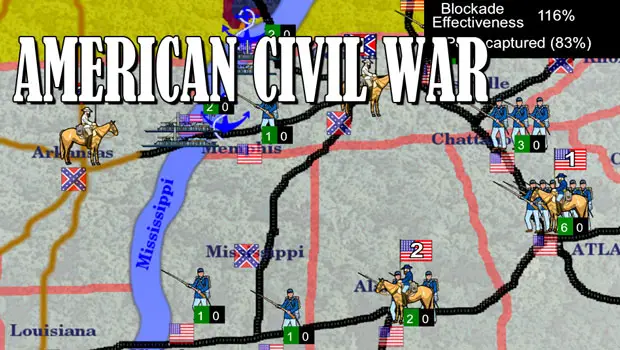 American Civil War is a historical military strategy game about the eponymous conflict from DK Simulations, putting you in command of the Union’s armies fighting to subdue the rebellious Confederacy. In a sea of mobile strategy games about the Second World War or fantasy settings, I was enthusiastic about the premise, and the game has some very strong elements, but ultimately American Civil War proves frustrating in more ways than one.
American Civil War is a historical military strategy game about the eponymous conflict from DK Simulations, putting you in command of the Union’s armies fighting to subdue the rebellious Confederacy. In a sea of mobile strategy games about the Second World War or fantasy settings, I was enthusiastic about the premise, and the game has some very strong elements, but ultimately American Civil War proves frustrating in more ways than one.
The game takes place on a map of the United States, with territories linked by lines showing where armies can move. You also have gunboats units along the Mississippi, which can quickly transport your armies up and down parts of the river you control and prevent enemy armies from crossing.Combat is resolved automatically and is very simple, based on a six-sided die roll plus added to modifiers based on each side’s general’s rating relative numbers, and the presence of fortifications, with one or both sides losing armies depending on the outcome. A six or better also forces the losing army to retreat—or, if it has no adjacent friendly territories to flee to, to surrender.
Each turn, you get five “builds” to create additional armies, new generals, river gunboats, or naval fleets. Meanwhile, the Confederacy gets four builds each turn by default, but unlike you, its number varies according to who controls strategically important territories s, along with the strength of the Union’s naval blockade. If the Confederacy has no builds on its turn, the Union is victorious. On the other hand, if Confederate troops hold too much Union territory or 20 turns pass, you lose.
I wanted to like this game more than I did. More historical strategy games for Android are always welcome, and this one takes its historical background more seriously than many. A Union victory is ultimately about destroying the Confederacy’s ability to sustain its armies and overwhelming it with the North’s superior numbers, the way the real war was won, rather than winning individual battles with brilliant generalship . It’s a cool touch that makes the historical setting integrally tied to the gameplay, instead of just window dressing.
Combined with the time limit, it also forces you to maintain continuous operations across the entire country and think about how to coordinate them. You’ll want a lot of armies in the Maryland/Virginia area to keep General Lee at bay and attack Richmond— but if you’re not also deploying resources towards other objectives like the Mississippi River or Atlanta, you’ll be desperately hurrying to catch up later. This sort of big-picture strategy is where American Civil War is strongest
Unfortunately, there are problems that hold the game back. Combat is very simple and very random, to an extent that often made me feel helpless— and the bigger and more important the battle, the less input you usually have, since large modifiers come into play mostly when a small force is being overwhelmed by a much larger one. That sort of crapshoot randomness is usually fine if it takes place on a relatively “micro” level where each individual roll of the dice is just one small part of the total outcome (a single attack in Risk, say), but that isn’t the case in American Civil War.
You start with less than 10 units and gain at most five per turn on standard difficulty, spread across a map that take several turns to cross. Individual units do not suffer damage or casualties. After a battle they’re either destroyed, or they’re not. A side’s ability to take effective action across an entire theater of the war and plans that took several turns and significant resources to come to fruition can be and frequently are shredded in one or two random rolls, and there is often little you can do to influence the outcome. It’s very frustrating, and frequently left me feeling like my choices didn’t really matter much.
There’s virtually no AI at all. Enemy armies act, or don’t, based on a random six-sided die roll added to the modifier of the enemy general and armies select territories to move to or attack based on very basic rules explained in the Help section. The ability to force a retreating army to surrender when surrounded adds some interest, but the scale of the map on which armies move is large enough that most states have only one or two territories, and they seldom connect to more than three others— severely limiting any maneuvering for position.
The graphics are rudimentary, which is OK. What’s not OK is that you can’t zoom the map in or out, either through the game’s user interface or with direct touch controls. You’re asked to pick “Best,”High,”Medium,” or “Low” resolution each time you start, and whatever map scale that gives you is what you’re stuck with unless you restart. There’s no audio at all— no music, no sound effects, not a solitary beep. Otherwise, the UI is fine, with all relevant information immediately visible. There’s no tutorial, but the Help section lays out the game mechanics clearly and succinctly.
I can’t recommend American Civil War. It’s certainly not terrible, but my enjoyment of the promising large-scale strategic elements was ultimately too weighed down by the frustration and frequent helplessness of combat and the arbitrary, ultra-simple AI. There are good ideas here, enough to make me think that DK Simulations has a Civil War strategy game I’d eagerly encourage you to play in them, but unfortunately this isn’t it.
Hardcore
Eh...
A promising attempt at historical strategy that ultimately falls short.




























